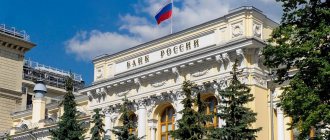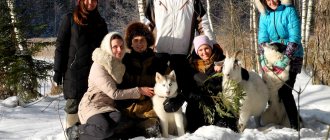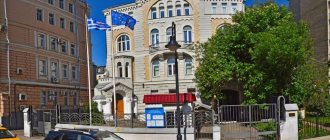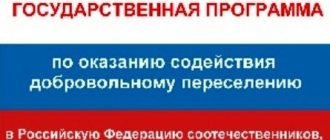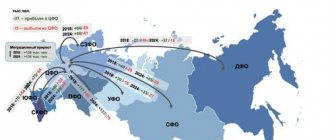Rosstat and various rating agencies closely monitor the cost of goods and services in various localities in Russia. All of them unanimously calculate the cost of living in one place or another in Russia. The methodology for identifying cheap cities included the cost of 275 basic goods and services, and the criterion for their selection was popularity among the population and frequency of use. The starting point was the average cost of a particular product in the country as a whole, which was considered 100%. As a result, the indicators either exceeded this value or were less than it, which indicated whether it was more expensive or cheaper to live in a given locality than the Russian average. This is how the cheapest cities in Russia were determined. Predictably, among the most “budget” Russian cities there were not those located around the largest metropolitan areas - in the Moscow and Leningrad regions.
Rating of Russian cities with the cheapest new buildings In recent years, the state of the Russian economy has left much to be desired, but this misfortune has resulted in a decline in prices for residential real estate. Employee…
Chill
The city with the unusual name Prokhladny is located in the northeast of Kabardino-Balkaria, from here to the capital of this republic - Nalchik - only 50 kilometers. The Malka River flows nearby. The cost of the standard consumer basket here is 79.27% of the all-Russian one. Prokhladny is also a regional center, and in terms of population in Kabardino-Balkaria it is second only to Nalchik. In 2015, approximately 57,900 people lived here. Prokhladnensky district is an agricultural region, and the city itself is a transport and industrial center.
Kirov
Population: 512,000 people. Cost of a 1-room apartment: from 1,300,000 ₽.
Kirov is located near such large cities as Kazan, Perm, and Nizhny Novgorod. The Vyatka River flows through the city. According to Kirovstat, for 2021 the average salary in the Kirov region is 27,576 RUR.
In Kirov it is quite problematic to find a job with decent pay, for example, if accountants in Moscow earn 60,000, then in Kirov no more than 25,000.
Renting apartments in Kirov is inexpensive - you can easily find a good two-room apartment in the center for 11,000 rubles. Residents of the city are not satisfied with the fact that there is little entertainment in Kirov.
Prokopyevsk
The next cheap city was Prokopyevsk from the Kemerovo region. The consumer price level there is 79.93% of the Russian average. The city is a regional center in the south of the Kuznetsk basin. Its area is 227.5 square meters. km, which puts it in fifth place in the Kemerovo region, but in terms of population it is in third place in the region, but only 92nd among all Russian cities. Prokopyevsk is part of the Novokuznetsk agglomeration, and its current population is 196,400 people. But the overall demographic dynamics here are negative - in recent years there has been a stable population decline. There are many reasons for this: an increase in mortality, a fall in the birth rate, although in the first decade of the 21st century the situation with this became more tolerable. But the main thing is that young people are in no hurry to work in the mines, preferring to go to other cities to study or look for easier earnings. As for age, this city is one of the oldest in Siberia - founded in 1651. Prokopyevsk is still a major coal mining center in the country.
Rating of Russian cities by standard of living in 2017
The 21st century has just begun, and Russia has already suffered 3 enormous economic shocks. And now we are waiting for improvement to come, and for our capricious “Mr. GDP” (we are talking about the gross product!) to slowly but surely begin to gain height.
Our well-being will grow along with it, but for now, we are making plans for tomorrow, for the week, for the year. We read the news chronicle, wonder where this notorious place is, where everyone is happy, and think why we are still not there.
Read the works of the American psychologist Maslow. In one of his treatises, he draws a direct connection between the level of development of a city (its infrastructure, climate, economy, the ability to provide the population with jobs) and the possibility of procreation. In developed settlements it is more convenient to start a business and build a career, get an education and even relax.
Russia, of course, is united, but regions within the country are developing differently. Why this happens is a topic for another discussion.
Our goal is to find out which city in our state has the highest standard of living, and, accordingly, where it is more convenient for us to live, raise children, study, and work. Since this issue is of great interest to ordinary citizens, most rating agencies and social institutions are engaged in clarifying it.
Can you trust the rating?
The level of trust in such a large-scale study depends on the purity of the experiment, the chosen evaluation criteria and the status of its organizers.
In general, it is everyone’s personal choice to believe or not to believe. In our case, when compiling a rating of Russian cities by standard of living, analysts used several effective approaches to produce an adequate result.
- The study was carried out by the Department of Sociology of the Financial University (a body operating under the Government of the Russian Federation);
- the analysis was carried out among 38 largest cities;
- The opinion of ordinary citizens obtained during surveys and information from Rosstat were taken into account.
The assessment was carried out according to important criteria:
- social sphere: level of well-being, types of educational services, their availability, effectiveness of healthcare services;
- the functionality of public services, the presence of new buildings in the city, emergency housing, the quality of roads;
- migration indicators: the ratio of the number of people who left/moved to the city and permanent residents, satisfaction with important areas of life, readiness to leave for another region.
Where is it good to live in Russia?
When compiling the rating, each city was assigned a final index (the ideal result is “1”, which means the highest score for all criteria).
Outsiders in the top ten include:
10: Orenburg (0.51%). Leads in the level of healthcare, quality and construction of roads, maintenance of housing stock
9: Novosibirsk (0.48%). A large industrial center, the capital of the region with many attractions. The third most populous city in the Russian Federation after Moscow and St. Petersburg.
8: Krasnoyarsk (0.54%). A million-plus city. Hydropower, machine-building industries, and non-ferrous metallurgy are developed. An important sports and educational center.
7: Yekaterinburg (0.55%). The largest transport interchange connecting North and South, East and West of the country. An industrial city, fourth in population. There are many prestigious educational institutions concentrated here. Excellent prospects for young people.
6: Chelyabinsk (0.46%). Center of the Southern Urals. A mineral depository with a well-developed industry. Much attention is paid to ecology, scientific progress, and improving the quality of roads. The negative point is the low average salary (about 30 thousand rubles).
In the top five:
Saint Petersburg
The fifth position in the ranking is occupied by the Northern capital (0.61%). The city of Peter the Great and revolutionary changes. It is unique in all respects, including. Thanks to its rich historical heritage, beauty and location on high water, many draw an analogy with Venice.
The cultural capital has become a favorite place of residence for 5 million people. Russian metropolis with a developed culture and education system. A center of pilgrimage for our and foreign tourists. Its drawbridges are designed ingeniously and present a unique spectacle against the backdrop of white nights.
Krasnodar
The wonderful capital of the Russian granary of Kuban and 4th place in the ranking (0.65%). The construction of new microdistricts is being carried out at a frantic pace. The number of people wishing to stay permanently in the southern city is growing even faster.
People are attracted by the mild climate, warm winters, the opportunity to live 100 km from the Black Sea and at the same time get a good education, and have the opportunity to open their own business. The city has a minimal number of unemployed.
Kazan
The third city in terms of quality of life with an index of 0.66%. The government implements many programs to improve welfare. Many new European-level roads are being built. The capital of Tatarstan is home to one of the oldest universities, which is the center of education in the region.
Much attention is paid to maintaining the cultural level of the national majority. The developed infrastructure is attractive. 96% of respondents expressed satisfaction with life.
Moscow
The golden-domed capital is in 2nd place (0.70%). Approximately 70% of indigenous residents believe that this is the most favorable city to live in the country. Almost all sectors of the national economy are represented here. The reconstruction of Moscow and the region is in full swing, the pace of construction is extremely high. The most beautiful city in the state is also the most expensive.
Tyumen
The Siberian city, the main one in the 72nd region, bypassed all the small and great capitals of the central regions. This cannot be a mistake, if only because the citizens give Tyumen the leadership for the second time in a row.
Of course, it takes first place based on the sum of all criteria. It is still far from absolute superiority - according to surveyed citizens, the best are the level of education, public services and road construction.
Well, which cities complete the rating list? The bottom three are Makhachkala, Omsk and Volgograd. These settlements also have their own charms and fans, but the facts are undeniable. Draw your own conclusions.
From the site: https://banki-v.ru/economics/rejting-gorodov-rossii-po-urovnyu-zhizni/
Gubkin
The city of Gubkin, located in the Belgorod region, fell just short of the top three in this rating. The basic consumer basket of goods and services here is only two hundredths of a percent higher than that of Prokopyevsk, which took third place. The city is located on the Okolets River in the north of the Belgorod region, from it only 20 km to Stary Oskol, and to Belgorod - quite far (116 km). It was unofficially recognized as the capital of the Kursk magnetic anomaly and the local “pearl”. Gubkin and Stary Oskol form a single agglomeration. Throughout the 90s, active infrastructure development took place here, and in 1999, a plant producing hot briquetted iron, which belongs to the Lebedyansky Mining and Processing Plant, began operating. Therefore, now Gubkin is a significant industrial center of the Belgorod region. In 2021, the population of Gubkin almost reached 87,000 people.
Large expensive cities
As a rule, large cities offer a high standard of living and high prices. For example, it will be much cheaper to buy or rent housing in a small town, but there will be fewer opportunities.
We analyzed the cost of the most necessary things and services for life in large cities of Russia and identified the most expensive ones.
Moscow
Moscow is located in the center of the East European Plain. The area of the city is 2561.5 km², and the population as of 2019 is just over 12.5 million people.
Surprisingly, this is not the most expensive city in the Russian Federation: despite the fact that living in the capital is usually more expensive, food prices there are perhaps the lowest in Russia. This is due to the fact that most of the companies producing goods are located within the city, which greatly reduces transport costs and, accordingly, affects prices in stores. The average cost of the most popular food products in the capital is as follows:
- chicken – 170 ₽/kg;
- pork – 300 ₽/kg;
- beef – 400 ₽/kg;
- milk – 55-75 ₽/liter;
- eggs – 55 ₽ per dozen;
- rye bread – 18 ₽/kg;
- wheat bread – 16 ₽/kg;
- trout – 330 ₽/kg;
- cod – 270 ₽/kg;
- cucumbers – 150 ₽/kg;
- tomatoes – 100 ₽/kg;
- carrots – 35 ₽/kg;
- apples – 90 ₽/kg;
- pears – 120 ₽/kg;
- oranges, tangerines – 80 ₽/kg;
- servelats – 750 ₽/kg;
- milk sausages – 350 ₽/kg;
- beer – 100 ₽/liter.
For comparison, in cities beyond the Arctic Circle, almost all of these products, with some exceptions, cost 2-3 times more.
In turn, real estate in Moscow is the most expensive in the country. The following areas were especially noted for their high housing prices:
- Kitay-Gorod (366,575 RUR/m²);
- Ostrozhenka (RUB 357,401/m²);
- Tverskaya (345,933 ₽/m²).
The cheapest areas were Kryukovo, Matushkino, Savelki, Silino and Staroye Kryukovo - where the average cost per square meter of housing was 107,797 rubles.
Learn more about the most expensive apartments in Moscow.
Speakers of the RBC Real Estate project, together with the head of Analytical Dmitry Taganov, discussed the rise in prices for apartments in the capital and predicted the further development of the situation:
Another important expense item for every city dweller is utilities, and Moscow tariffs for them are quite high. According to the official website of the mayor of the capital, the cost of housing and communal services is as follows:
- heating - about 2000 ₽/Gcal;
- water supply (hot water) – 192 ₽/m3;
- gas supply – 5.50 ₽/m3;
- water supply (cold water, sewerage) – 38.70 ₽/m3 and 27.47 ₽/m3;
- electricity – 5.47 ₽/kWh;
- housing services – 28 ₽/m².
Despite having the most developed transport system in the country, tariffs for its use are also the highest.
For a “Unified” travel ticket, the fare is 55 rubles. With the Troika card, which covers trams, trolleybuses, buses and the metro, a passenger will pay 38 rubles for travel.
Driving your own vehicle will also require significant financial investment. For example, gasoline prices in Moscow are as follows:
- AI-95 – 46 ₽/l;
- AI-92 – 42 ₽/l;
- AI-98 – 50 ₽/l;
- DT – 47 ₽/l.
Moscow is one of the largest tourist centers in the country with a large number of attractions, architecture, culture and sports. In this regard, the city has the most developed transport infrastructure in the country and the widest range of services provided in general and in the field of tourism in particular.
A cable car is open for tourists in Moscow
According to the Mosgorstat organization, the average salary in Moscow is 71,200 rubles. taking into account tax deductions.
The minimum wage in the capital from January 1, 2021 is 18,781 rubles.
The Fincan portal noted the following areas of activity as the most profitable:
- transport sector - income from 60,000 ₽/month;
- information technology – from 70,000 to 150,000 ₽/month;
- financial sector – from 60,000 to 150,000 ₽/month;
- jurisprudence – from 90,000 to 130,000 ₽/month.
The highest paying field of activity in the capital is show business, which brings specialists income from 70,000 rubles. per month. Engineers earn from 70,000 to 100,000 rubles. per month, middle managers in large companies - from 65,000 rubles. per month.
Saint Petersburg
St. Petersburg is the second most populous city of federal significance in the Russian Federation, the administrative center of the Northwestern Federal District and the Leningrad Region.
The city was founded on May 16, 1703 by Peter I, and in 1712-1918 it was the capital of the Russian state. It was in honor of the emperor that it got its name.
The main income for St. Petersburg comes from the tourism industry, so it is not surprising that prices are set quite high here, since they are primarily aimed at visitors
Not everyone can become a real St. Petersburger, since buying your own home will cost an average of 120,000 rubles. per square meter. High real estate prices are associated with the city's great popularity among tourists and ample opportunities: St. Petersburg boasts many prestigious educational institutions, elite business companies and successful enterprises.
Utility prices are also impressive:
- heating -1775.45 ₽/Gcal;
- electricity (in houses with gas stoves) – 4.61 ₽/kWh;
- electricity (in houses with electric stoves) – 3.46 ₽/kWh;
- water supply (cold water) – 30.60 ₽/m3;
- sewerage – 30.60 ₽/m3;
- gas supply – 6.28 ₽/m3.
Heating tariffs deserve special attention, since St. Petersburg is located in a fairly cold region of the country. Despite the fact that prices for housing and communal services here are generally lower than in Moscow, with a high degree of probability, during the entire heating season, St. Petersburg residents will have to pay more than Muscovites.
The transport system in the city is well organized, so slightly inflated ticket prices do not cause indignation. Travel by land transport (trams, trolleybuses, buses) will cost 40 rubles. for one trip. The cost of travel on the metro is 45 rubles.
Drivers and owners of their own cars will be pleased with the fact that fuel prices in St. Petersburg are lower than in Moscow:
- AI-92 – 41.4 ₽/l;
- AI-95 – 44.9 ₽/l;
- AI-98 – 45.9 ₽/l;
- DT – 49.6 ₽/l.
The cost of food in St. Petersburg stores is for the most part slightly higher than in the capital. This is due to transport costs: many goods are brought into the city from other localities. Average prices for basic products in St. Petersburg are as follows:
- chicken – 200 ₽/kg;
- pork – 460 ₽/kg;
- beef – 600 ₽/kg;
- milk – 60 ₽/liter;
- eggs –70 ₽ per dozen;
- bread – from 15 ₽;
- fish – from 240 ₽/kg;
- cucumbers – 50 ₽/kg;
- tomatoes – 120 ₽/kg;
- carrots – 40 ₽/kg;
- apples – 70 ₽/kg;
- pears – 130 ₽/kg;
- oranges, tangerines – 80 ₽/kg;
- sausages – from 400 ₽/kg.
Speaker of the Youtube channel “Pick up and go!” Vladimir Karmanov spent about a month in St. Petersburg and made a video about interesting features of the city, including prices and the mentality of local residents:
The average salary in the city is 47,000 rubles. The highest salaries are paid to workers in the economic sphere (about 71,800 rubles) and scientific industries (about 70,400 rubles). The lowest incomes are among employees in the healthcare, education and communications sectors (about 41,000 rubles)
Khabarovsk
Khabarovsk is a city of regional significance with an area of 386 km², the administrative center of the Khabarovsk Territory, one of the largest political, educational and cultural centers of the Far East. At the end of 2021, Rosstat estimated that the city's population was 618,150 people. The main working industry in Khabarovsk is the production of metal products, chemical industries, and mechanical engineering.
The speaker of the Youtube channel “Miscellaneous about Khabarovsk and not only” and the owner of the publishing house “Khleb” Ilya Andreev talk about the largest enterprises of the city:
It will be easier to become a home owner in this locality than in Moscow or St. Petersburg: the cost of apartments in a new building starts from 1.5 million rubles. For apartments that do not belong to the elite segment, the maximum price does not exceed 5 million rubles.
According to data from the Self-Accounting RCC for processing utility payments, in 2021, tariffs for basic utilities will be increased by an average of 2.4%. Below are prices for basic services before increases:
- heating – 2500 ₽/Gcal;
- electricity – 4.51 ₽/kWh;
- water supply (cold water) – 41.77 ₽/m3;
- water supply (hot water) – 41.77 ₽/m3;
- sewerage – 33.46 ₽/m3;
- gas supply – 7.10 ₽/m3.
Prices for ground transport in Khabarovsk are set at 25 rubles. However, there is also a night tariff (30 rubles) and a reduced tariff in certain areas with high traffic (20 rubles).
Average cost of fuel for cars:
- AI-92 – 41.5 ₽/l;
- AI-95 – 43.5 ₽/l;
- DT – 47 ₽/l.
Due to the geographical location of the region, food prices are very different from the European part of the country. At the beginning of 2021, the average cost of the most commonly used goods was at the level of:
- milk – 70 ₽/l;
- bread – from 20 ₽;
- beef – from 450 ₽/kg;
- chicken – from 200 ₽/kg.
Video review of prices in the local Samberi store at the end of January 2019:
The average salary in the city is about 45,000 rubles. The highest salaries are for specialists in the real estate sector (from 60,000 rubles), the lowest incomes come from professions in sports and cosmetology services (about 34,000 rubles per month).
Sochi
Sochi is the country's largest resort city, an important transport hub, as well as a major economic and cultural center of the Black Sea coast. Unofficially also called the summer, southern and resort capital of the Russian Federation. After the Winter Olympic Games in 2014, the city underwent a significant transformation, becoming one of the largest sports centers in the country.
The cost of apartments in Sochi is comparable to the lowest price segment of the capital's real estate. On average, you will have to pay 110,000 rubles per square meter in an apartment building. One hundred square meters of land will cost about 800,000 rubles.
According to the city portal, at the end of 2021, tariffs for essential housing and communal services were within the following limits:
- heating – 2371 ₽/Gcal;
- electricity – 4.61 ₽/kWh;
- water supply (cold water) – 32.60 ₽/m3;
- water supply (hot water) – 32.60 ₽/m3;
- sewerage – 29.65 ₽/m3;
- gas supply – 6.03 ₽/m3.
The cost of public transport in the central region of Sochi is 19 rubles. The road to the Lazarevsky and Tuapse districts can cost 292 rubles. by train Swallow).
As for gasoline prices, they are slightly lower than in the capital. A liter of fuel costs:
- AI-92 – 43.10 ₽;
- AI-95 – 46.65 ₽;
- AI-98 – 53.44 ₽;
- DT – 44.80 ₽.
The speaker of the Youtube channel “Northerners in Sochi” made a video with an overview of prices on the Adler and Sochi markets:
Prices for products are comparable to their cost in the central regions of the country:
- liter of milk – from 42 ₽;
- bread – from 16 ₽;
- beef and pork – from 350 ₽ per kilogram;
- chicken - from 110 ₽ per kilogram.
At the same time, the cost of a kilogram of vegetables and fruits is significantly lower than in most other Russian cities:
- tomatoes – from 50 ₽;
- cucumbers – from 40 ₽;
- apricots – from 60 ₽;
- apples – from 45 ₽.
Lower prices for fruits and vegetables are associated with their cultivation in areas located in close proximity to Sochi. Accordingly, the cost of delivering these products to Sochi stores is not so high.
According to the Trud portal, during the year the average salary level in Sochi remained stable
The average salary in the city is 34,000 rubles. The highest paying sector in the city is the real estate sector with an average salary of 115,000 rubles, the lowest paid are manufacturing and transport (32,500 and 33,000 rubles, respectively).
Vladivostok
Vladivostok is a port city in the Far East, as well as a political, cultural, scientific, educational and economic center of the region, located on the Muravyov-Amursky Peninsula and islands in Peter the Great Bay in the Sea of Japan. The terminus of the Trans-Siberian Railway, one of the largest seaports in the Far Eastern basin, the main base of the Pacific Fleet. The population is 607,348 people according to Rosstat at the beginning of 2021.
The main branches of the manufacturing industry are (mechanical engineering, shipbuilding, ship repair, food production and others). Construction, agriculture, energy, gas and water supply are in an unfavorable position.
Food prices in this city are significantly lower than in the capital, but fruits and vegetables, as well as dairy products, are more expensive.
A Youtube user posted a video reviewing the cost of fish products on the market in Vladivostok in January 2021:
The portal of the Gordosky real estate center of Vladivostok reports that the cost of real estate in the city starts from 105,000 rubles. per square meter. Average regional utility tariffs are quite high:
- heating – 3000 ₽/Gcal;
- electricity – 2.99 ₽/kWh;
- water supply (cold water) – 30.36 ₽/m3;
- water supply (hot water) – 35 ₽/m3;
- sewerage – 20 ₽/m3;
- gas supply – 43.78 ₽/m3.
Public transport in Vladivostok includes buses, trams, trolleybuses and a funicular. The cost of one trip on a bus is 21 rubles, on a tram or trolleybus – 14 rubles, on a funicular – 12 rubles.
A liter of AI-92 gasoline in Vladivostok costs an average of 40 rubles, AI-95 - 44 rubles.
The Trud portal noted that the average salary in the city gradually increased throughout the year
According to the Fincan portal, the highest incomes in Vladivostok are received by specialists in the field of top management - from 55,000 rubles. per month. The lowest average salary for workers in the advertising industry is about 35,000 rubles.
Kizlyar
The next city where everything is cheap is Kizlyar from Dagestan. Here you can save a lot of money by spending only 79.98% of the national average on essentials. Kizlyar is the administrative center of the district of the same name. It is located on the left bank of the Terek in the Caspian lowland. From here it is only 60 kilometers to the Caspian Sea, and to the capital of the republic, Makhachkala, 140 kilometers to the southeast. The territories on the right bank of the Terek began to be actively populated and developed in the 50s of the last century, and before that they were deserted. Now half of the city’s territory is located here - in addition to private houses, the modern microdistrict “Cheryomushki” has appeared. During the war in Chechnya, Kizlyar became notorious not only in Russia, but also in the rest of the world due to the terrorist attack that happened here in January 1996. Currently, 48,300 residents live in Kizlyar.
List of the 15 best attractions in MoscowThanks to its history, noisy, huge, ancient Moscow is rich in various sights and interesting historical places. It's impossible to...
Where is the cheapest real estate in Russia?
The housing issue remains one of the pressing issues for many Russian families. Apartments in newly built luxury buildings can afford to buy units, others are looking for inexpensive housing, and some even agree to move to where it will be more affordable for them. And there are many regions in Russia where housing is inexpensive.
Recently, when the government plans to move from words about the resettlement of single-industry towns to action in the near future, the Ministry of Economic Development has already decided to liquidate more than 340 settlements and resettle their residents. Housing in them also began to rapidly become cheaper. So, for example, in one of these settlements, in the city of Asbest, Sverdlovsk region, a three-room apartment with an area of 50 square meters costs 1 million rubles, that’s 20 thousand rubles per square meter. These are the prices for real estate in other cities on the list planned for resettlement, which also included Astrakhan and Lipetsk.
Closer to the capital
It is clear that living in depressed regions, where housing is becoming more affordable every day, does not attract the working population. This category of Russian citizens has the opportunity to purchase affordable housing closer to the capital.
So, for example, it is quite possible to buy an apartment in Smolensk, where a square meter costs about 24 thousand rubles. Analysts predict a decline in prices for apartments in the Moscow region in the near future; it could reach 5%. By the way, in the capital there is a real opportunity to purchase a one-room apartment for “only” 2 million rubles in the Northern Izmailovo district. Such a low price is due to the size, which cannot be increased by any redevelopment.
And the further you look for housing from the capitals, the cheaper the purchase will be. Stavropol and Novokuznetsk are competing for first place in the list of large Russian cities (more than half a million inhabitants) with the cheapest housing according to 2014 data. One square meter of living space on the secondary market will cost the buyer 37-40 thousand rubles, however, there are also more expensive offers - in the field of luxury real estate and new luxury buildings, but even for them the cost does not exceed the limit of 45-50 thousand rubles. The bulk of the housing stock in these cities is old houses, including Khrushchev-era buildings, and the demand for new housing exceeds supply, since not enough new houses are being built.
According to data at the beginning of 2014, the ranking of the twenty cheapest cities in Russia by average cost of housing is as follows:
Kineshma (Ivanovo region) - 23,754 rubles per square meter
Prokopyevsk (Kemerovo region) - 30,438 rubles per square meter Gubkin (Belgorod region) - 31,618 rubles per square meter Bratsk (Irkutsk region) - 34,358 rubles per square meter Engels district (Saratov region) - 35,893 rubles per square meter
Purchasing real estate is an excellent investment. But it is necessary to approach this issue legally, since incorrect registration leads to the loss of money or the property itself. Therefore, if you do not understand the law, be sure to seek advice from a specialist. Decide on a purchase budget, which usually consists of the cost of real estate, the cost of registering property rights, as well as real estate and legal services. Familiarize yourself with the situation on the real estate market in your region . This can be done by purchasing a special newspaper or going to the website of one of the agencies.
If you are not satisfied with the prices in an area you are tentatively considering as a convenient place to live or do business, look to other options. By spending time searching, you can choose the option that suits you. Choose a real estate agency if you haven’t found advertisements for the sale of real estate on the Internet or in print that would interest you. It can also be found either through the World Wide Web or through advertising in the press. Be sure to check reviews for the organization you choose.
An agency with a good reputation is more reliable than one that has just opened. Tell the agents as completely and accurately as possible what you want to buy, where, at what price and how soon, since for many reasons the transaction may be delayed for some time. For example, if you buy an apartment in which children are registered, or it is in shared ownership, and one of its owners lives in another city. Inspect the property offered to you. Treat this procedure responsibly so that there are no misunderstandings later. Check all the necessary documents, find out whether any difficulties may arise when completing the transaction, and whether it is possible at all. The agency most often has its own lawyer who checks the documentation. Discuss how payment will be made (non-cash or cash). Conclude a purchase and sale agreement, transfer the funds. Submit your documents to the EIRC for re-registration. Do not forget that after purchasing real estate, you can make a refund of 13% of its cost. The state provides this opportunity to every citizen once in his life.
From the site: https://www.kakprosto.ru/kak-822640-gde-v-rossii-samaya-deshevaya-nedvizhimost
Kanash
The next “economical” city is located in Chuvashia and it is called Kanash. Here you can spend only 80.25% of the amount needed on the national average on the consumer basket. Kanash acquired the status of a city in 1925, and now it is the center of the Kanash region. In Chuvashia it is a prominent transport, industrial, and railway center. Kanash is located 77 kilometers from Cheboksary on a hill near the watershed of the Kubnya and Maly Tsivil rivers. Currently, 45,500 people live there.
Where is the best place to live in Russia: the most comfortable city in 2016.
Despite the fact that the authors of the study identified two nominations, answering the question of where it is better to live in Russia, one cannot ignore the results of the All-Russian competition “The Most Comfortable City in Russia”, held by the Russian Government.
Ecology, architecture, historical, cultural and natural heritage, public transport, development of a public-private partnership system, improving the quality of services provided to the population, accessibility of the environment for people with disabilities and other factors were selected as criteria.
According to the results of the competition, in 2021 Stavropol was recognized as the most comfortable urban settlement. It is noteworthy that this is not the first time Stavropol has been awarded such a title.
Kovylkino
A town from Mordovia was also included in the list of the cheapest cities to live in. There you can buy 275 essential products (if you can find them) at 18.22% cheaper than in Russia as a whole. This city stands at the confluence of the Lashma River into the Moksha, from here it is 116 kilometers to Saransk. This is a rather old settlement - back in 1237, there was the village of Lashma, through which the river of the same name flowed. Then for a long time this village was part of the Golden Horde. Only in 1937 the city was given its modern name - in honor of Stepan Kovylkin, Commissioner of Railways. In 1928, the village was elevated to the status of a regional center, although it received city status only in 1960. During the 70-80s, the city experienced active development.
Volgograd
Another city that has been uninhabitable since 1943, it seems. Outwardly, it looks like Novorossiysk: shabby, dirty, with poor infrastructure, but filled to the brim with patriotic pathos. Among cities with a population of over a million, Volgograd has been confidently among the worst cities in Russia for many years: there is a high level of unemployment, corruption and crime, poor quality of roads, an oppressive atmosphere and eternal problems with infrastructure. Letting children go for walks in some areas is downright dangerous. Visiting Mamayev Kurgan with your family is a good idea. Living near him is obviously bad.
Krasnokamensk
Trans-Baikal Territory also received its representative in this rating. It was Krasnokamensk, where prices are 81.78% of the average in Russia. This city is located in the south of Transbaikalia, in the foothills of the Argun Range, 380 kilometers from Chita, but 97 kilometers from Mongolia, and 49 kilometers from China. In terms of area, Krasnokamensk is the second city in the region. Krasnokamensk is connected to Chita by a railway line. This is a typical single-industry town, which in 2007 was recognized as the most comfortable in the Chita region. However, before that it was awarded the same title at the level of the entire country, although Krasnokamensk received the status of a city only in 1969. Now 52,800 people live there.
10 places worth visiting in SochiThe Russian city of Sochi has become one of the most attractive tourist destinations. In and around it there are a lot of interesting places, attractions…
Stavropol
Population: 433,931 people. Cost of a 1-room apartment: 1,600,000 ₽.
A fortress in the steppe that became the city of the cross - this is how one can characterize the history of the emergence of Stavropol . The city is located in the North Caucasus, in the southern part of Russia.
Visitors often call Stavropol the greenest Russian city - there are many squares and forests, flower beds and front gardens. The city is easy to breathe and pleasant to be in. But, of course, not without negative sides - cars with their harmful emissions are the main source of air pollution (as in all cities).
If we talk about the climate, it is very hot here in the summer, and so cold in the winter that you don’t want to go outside. It is better for heat-loving people not to settle in the Northwestern and Southwestern regions - it is cold here and the wind blows, one might say, all the time.
Dace
In the Lipetsk region there is the ancient city of Yelets, prices in which can also please, since they are 17.62% lower than the general level for the country. The city is located in the west of the region, from it to Lipetsk 78 kilometers, and the Bystraya Sosna River flows through it. It is the administrative center of the district of the same name, although the administration of the city and the district are separate. In 2007, it was awarded the title of “city of military glory.” Now 105,000 people live there. Several streams that dry up in summer flow through the city, one of which, Luchok, gave its name to one of the city districts.
Chelyabinsk
The city of metallurgists and asthmatics. The place is on the verge of an environmental disaster: in winter, the children's hospital in the AMZ area is covered with black snow from factory emissions. The city is extremely dirty - and not only because of industries: local residents often complain about public services. There is a developed infrastructure, reputable universities and, in principle, a decent standard of living - but there is absolutely nothing to breathe. Children born in Chelyabinsk suffer from chronic diseases of the respiratory tract, skin, vision and mucous membranes. It’s better to get out of here and somewhere far away.
Chernozem region and the Urals: the most affordable square meters
The most affordable prices for secondary housing are in the Black Earth Region, the Urals and the south of Russia. The last, 50th place in the ranking was taken by Magnitogorsk (same as last year). The cost per square meter here remains stable compared to 2021 and is equal to 31,041 rubles. Secondary apartments are slightly more expensive in Novokuznetsk (49th place) and Bryansk (48th place). Kirov still holds 47th place. Stavropol rose one line, to 45th place (in April 2021, a square meter here cost 40,352 rubles, which is 1% higher than a year earlier) and overtook Astrakhan. It took 46th place: housing prices here fell by 1.6%. In Kursk, which moved up one line, the price per square meter rose by 1.3% over the year. The remaining participants in the top 10 swapped places due to different rates of price decline: Togliatti and Ulyanovsk rose in the ranking, and Chelyabinsk lost two positions at once with a price drop of 1.8%.
Chelyabinsk. gon4./Depositphotos
10 cities with the lowest cost per square meter
| April 2021: top 10 | April 2021: cost per sq. m, rub. | April 2021: place in the ranking | Dynamics | April 2021: place in the ranking | April 2021: cost per sq. m, rub. | April 2021: top 10 |
| Chelyabinsk | 41 292 | 41 | -2 | 41 | 40 965 | Ulyanovsk |
| Ulyanovsk | 41 151 | 42 | +1 | 42 | 40 816 | Tolyatti |
| Tolyatti | 41 082 | 43 | +1 | 43 | 40 550 | Chelyabinsk |
| Astrakhan | 40 605 | 44 | -2 | 44 | 40 416 | Kursk |
| Kursk | 39 898 | 45 | +1 | 45 | 40 352 | Stavropol |
| Stavropol | 39 537 | 46 | +1 | 46 | 39 949 | Astrakhan |
| Kirov | 38 616 | 47 | 0 | 47 | 39 056 | Kirov |
| Bryansk | 37 484 | 48 | 0 | 48 | 37 178 | Bryansk |
| Novokuznetsk | 33 705 | 49 | 0 | 49 | 35 366 | Novokuznetsk |
| Magnitogorsk | 31 087 | 50 | 0 | 50 | 31 041 | Magnitogorsk |


